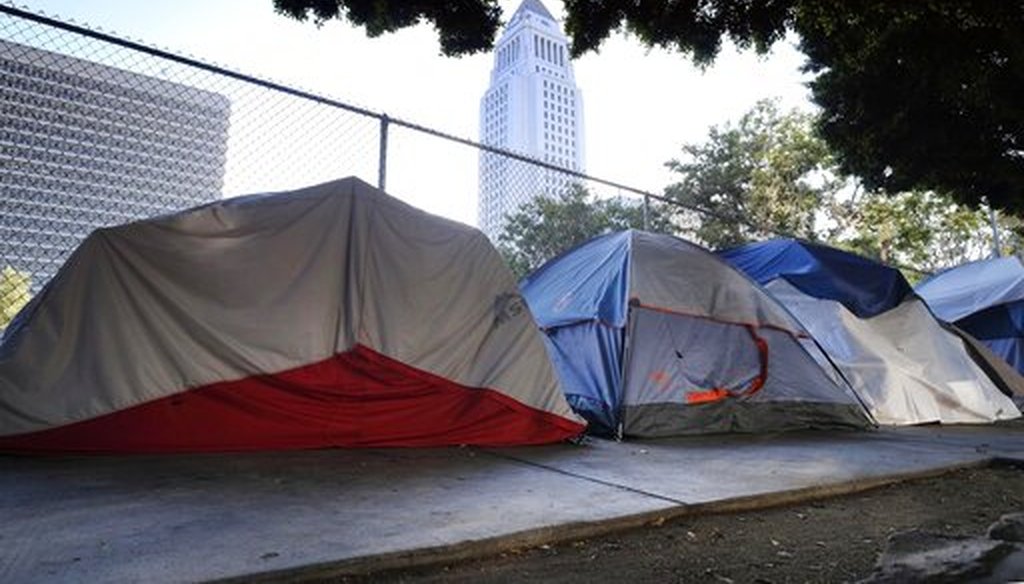Get PolitiFact in your inbox.

Los Angeles City Hall is seen behind a homeless tent encampment along a street in downtown Los Angeles on July 1, 2019. (AP/Vogel)
Democrats on the November debate stage in Atlanta turned the spotlight to an issue affecting millions of Americans when they were asked how they planned to make housing more affordable.
"Where you put your head at night determines so many things about your life," billionaire Tom Steyer said during the Nov. 20 debate. "It determines where your kids go to school. It determines the air you breathe, where you shop, how long it takes you to get to work."
Our housing crisis is directly tied to the deep inequality we see across the country. My plan invests in sustainable housing solutions to get working families homes they can afford—because where you send your kids to school and the quality of the air you breathe matters. pic.twitter.com/am8RfMqarH
— Tom Steyer (@TomSteyer) November 25, 2019
Steyer and Sen. Elizabeth Warren, D-Mass., pledged to build millions of housing units across the country, criticizing local and municipal policies that have limited new construction.
"Our housing problem in America is a problem on the supply side, and that means that the federal government stopped building new housing a long time ago, affordable housing," Warren said. "So I've got a plan for 3.2 million new housing units in America."
The United States has a housing affordability problem. Home prices are rising faster than wages in roughly 80% of U.S. markets, according to ATTOM, a real estate and property data company. Almost two-thirds of renters nationwide say they couldn’t afford to buy a home if they wanted to.
The prospects aren’t much better for renters, either. Approximately 18.5 million households were spending more than half their income on housing in 2016. There’s not a single county nationwide where a minimum wage earner working 40 hours per week can afford a "modest" two-bedroom apartment without being cost-burdened, according to government standards.
"Housing affordability is at crisis levels," said Robert Dietz, chief economist for the National Association of Home Builders.
The topic has taken a backseat on the campaign trail to hot-button issues like health care, but the candidates in Atlanta weren’t the only ones to take a stab at it. Democrats in Congress have recently introduced bills on housing, and President Donald Trump signed an executive order in June to establish a council focused on removing regulations that limit the supply of housing.
In September, the U.S. Treasury quietly unveiled a separate Trump administration plan to reshape the housing market by reducing the federal government’s role.
PolitiFact checked out the available research and talked to experts to get a sense of how bad the nation’s affordable housing problems have become for both homeowners and renters.
The federal government considers housing affordable when a resident can pay for it using less than 30% of his or her gross income. By that standard, full-time workers earning the minimum wage can’t afford a "modest" two-bedroom apartment without being cost-burdened.
In other words, there’s not enough affordable housing to go around for low-income people.
Sarah Saadian, senior director of public policy for the National Low Income Housing Coalition, told us her group’s research found that for every 100 extremely low-income households, there are just 37 affordable rental homes available on the market.
In fact, the NLIHC estimates that the United States has a shortage of 7 million affordable rental homes for Americans with incomes below the poverty line or 30% of the local median income.
Many of the lowest earners are elderly or disabled, Saadian said. Others are in school or single parents. And Native American, black and Hispanic renters are more likely than white renters to have the type of extremely low incomes that make housing a severe burden.
But housing is not just an issue for the lowest-earning renters. Experts told us that there has been a more general trend toward greater housing unaffordability over the last decade, with the problem being particularly pronounced in major coastal cities such as Los Angeles or Boston.
Robert Silverman, professor of urban and regional planning at the University of Buffalo, said that a second group stung by the crisis includes people looking to purchase a home for the first time.
According to an annual report from Harvard University’s Joint Center for Housing Studies, the ratio of median home prices to median household incomes is back near peak levels across the country. Similarly, the National Association of Home Builders’ Housing Opportunity Index, which tracks the share of homes in an area that would be affordable to a median-income family, is close to a 10-year low.
As home prices go up, homeowners accrue more wealth, and younger generations looking to buy their first home get priced out of the market, Dietz said.
That problem is getting worse as older Americans are living longer and spending more time as homeowners, meaning they don’t cycle out of the housing market as often as they used to.
Housing affordability is a transportation issue, as well.
"People often have to move further out to find affordable housing," Silverman said. "That can translate into higher transportation costs and commute times."
A 2015 Brookings Institution study found that between 2000 and 2012, the number of jobs within the typical commute for people in major metro areas fell by 7%.
The Center for Neighborhood Technology, a Chicago-based nonprofit focused on sustainable development, calculates an H+T Affordability Index that factors in the impact of transportation. It shows that there’s more to housing affordability than finding a roof to live under.
For example, residents in Atlanta, a city known for its sprawl, spend on average 48% of their incomes on housing and transportation, according to the H+T Affordability Index. But people living in dense New York City only devote 39% of their incomes to housing and transportation.
There are additional tradeoffs, too. "It’s about being able to cover the rent and not skimp on food and other necessities," said Alex Schwartz, professor of urban policy at the New School.
One response to sky-high housing prices is simply to build more housing units. But experts said a number of factors contribute to housing unaffordability and make it a difficult problem to solve.
For starters, incomes have stayed flat while home prices and rents have continued to increase since the 2008 recession, Silverman said.
"After inflation, incomes have barely budged, and real rents have been increasing over time," Schwartz said. "At the same time, you’ve had very little increase in rental subsidies."
There has also been a lull in construction, which Dietz said has been limited by the "five L’s," meaning labor, lots, lumber, lending and laws. He said there’s a shortage of construction labor, a low supply of lots, jacked-up prices for lumber, tight conditions for lending and restrictive laws.
Exclusionary zoning laws — as restrictive measures are often called — include neighborhood bans on certain types of developments, such as trailer parks, as well as rules establishing minimum lot sizes or requiring that housing units include a certain number of parking spots.
These regulations are fueled by "not in my backyard" sentiments and shrink the pool of housing options available. Studies suggest they slow down the nation’s broader economic growth, too.
Politicians looking to build new homes — like Steyer and Warren — would seek to unravel these zoning rules. Experts said that would be a smart first step, especially for helping homeowners.
"Reducing regulatory burdens on home construction is the clear, bipartisan policy to add new housing construction — for rental and for-sale housing," Dietz said.
But even if local communities scrapped unnecessary land use and zoning laws, there would still be a severe shortage of affordable rental homes for the very poorest households, Saadian said.
Schwartz agreed. "I think it’s highly unlikely that increases in housing supply are appreciably going to improve the situation for the people who bear the biggest rent burdens," he said, adding that the poorest people struggle to pay for utilities and insurance, let alone rent.
For that reason, zoning changes would have a bigger positive impact on homeowners, he said.
Experts told us that low-income renters would benefit more from an expansion of existing rental assistance programs, which are not currently distributed to everyone who needs them.
"Despite the clear need, only 1 in 4 households eligible for housing assistance receive any help," Saadian said. She said Congress should spend more on rental assistance and the federal Housing Trust Fund, which helps build affordable homes for low-income Americans.
"The groups most negatively impacted by the affordability crisis are first time homebuyers and low-income renters," Silverman said. "Addressing the needs of both groups would require more public intervention in the form of rent subsidies, mortgage interest deductions and tax credits, and zoning and land-use reforms that incentivize more development."
Our Sources
The Washington Post, "Transcript: The November Democratic debate," Nov. 21, 2019
U.S. Department of the Treasury, "Treasury Department Submits Housing Reform Plan to President," Sept. 5, 2019
The White House, "President Donald J. Trump is Tearing Down Red Tape in Order to Build More Affordable Housing," June 25, 2019
The Center for Neighborhood Technology, "H+T Affordability Index," accessed Nov. 26, 2019
Harvard University, "The State of the Nation’s Housing," 2019
The National Low Income Housing Coalition, "Out of Reach," 2019
The Brookings Institution, "Housing trade-offs: Affordability not the only stressor for the middle class," May 8, 2019
The University of Chicago, "Housing Constraints and Spatial Misallocation," April 2019
The Brookings Institution, "The growing distance between people and jobs in metropolitan America," March 2015
NPR, "Democrats Talk Housing Affordability," Nov. 23, 2019
Curbed, "Housing should be funded like infrastructure. Now Congress has a plan for that," Nov. 21, 2019
Curbed, "The affordable housing crisis, explained," May 15, 2019
Forbes, "America's Housing Affordability Crisis Only Getting Worse," Jan. 31, 2019
Housing Wire, "Home prices are rising faster than wages in 80% of U.S. markets," Jan. 10, 2019
Curbed, "The changing face of retirement: Apartment living, active lifestyles, and rural homes," May 22, 2018
The Wall Street Journal, "More Renters Give Up on Buying a Home," April 3, 2018
Governing, "Family Housing Affordability in U.S. Cities," November 2015
Vox, "Everything you need to know about the affordable housing debate," May 11, 2015
PolitiFact, "Trump policies Duckworth cited haven’t hurt housing access — yet," Sept. 20, 2019
PolitiFact, "Scott's right: 'Modest' two-bedroom apartments not affordable at minimum wage," July 30, 2019
PolitiFact, "Yes, millions of families spend the bulk of income on housing," May 2, 2019
PolitiFact, "Is housing unaffordable for full-time minimum-wage workers in 99 percent of counties in America?," July 25, 2018
PolitiFact, "Ocasio-Cortez: In New York City, there are 3 vacant apartments for each homeless person," July 25, 2018
PolitiFact, "Donald Trump wrong that black homeownership rate is at a record high," Dec. 11, 2017
Email interview with Robert Dietz, chief economist for the National Association of Home Builders, Nov. 26, 2019
Email interview with Robert Silverman, professor of urban and regional planning at the University of Buffalo School of Architecture and Planning, Nov. 26, 2019
Email interview with Jenny Schuetz, a fellow at the Metropolitan Policy Program at the Brookings Institution, Nov. 26, 2019
Phone interview with Alex Schwartz, professor of urban policy at the New School, Nov. 26, 2019
Email interview with Sarah Saadian, senior director of public policy for the National Low Income Housing Coalition, Nov. 26, 2019






























